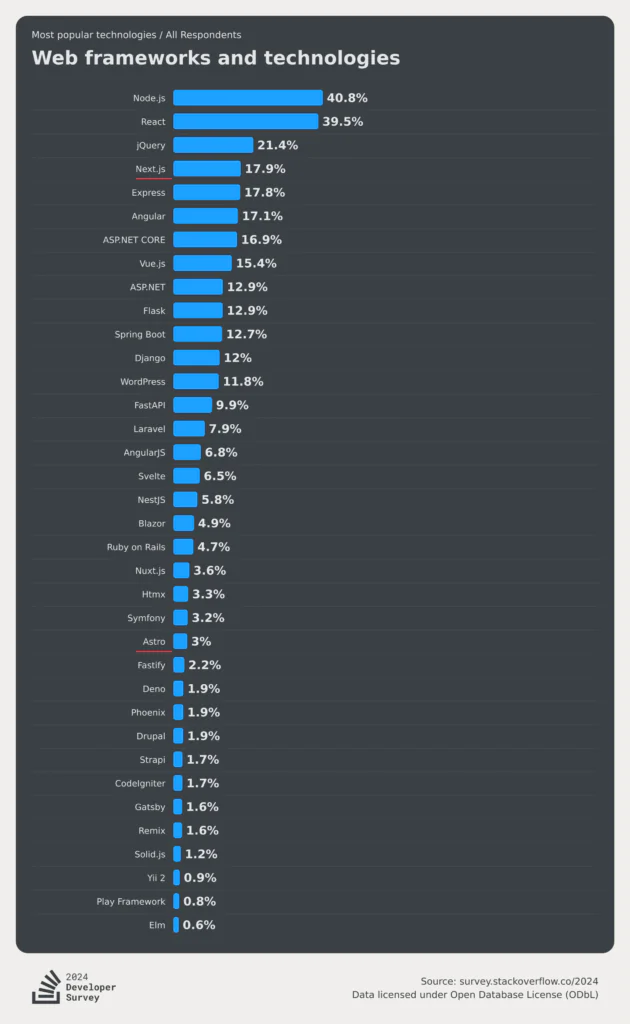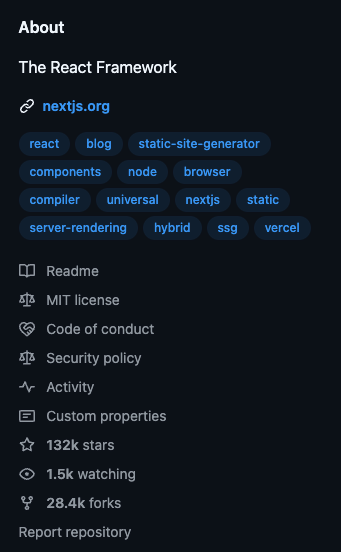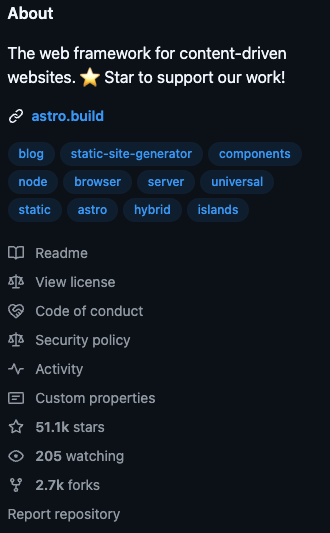Astro vs Next.js: Choose the Right Framework in 2025
 Pagepro
Pagepro
Introduction
Astro vs Next.js has become one of the most common dilemmas in frontend development. In 2025, the difference between the two grew beyond the static vs. dynamic debate. While Astro pushes forward with selective hydration and view transitions, Next.js is evolving into a full-stack framework with React Server Components and App Router.
Today, we’ll compare Astro vs Next.js to give you a better understanding of their similarities, differences, and best use cases. Those of you who prefer watching to reading are in luck – we’ve also prepared a video on this topic:
Before we move on to a proper comparison, let’s start by examining both frameworks.
What is Next.js?
Next.js is a popular React-based framework created by Guillermo Rauch, CEO of Vercel. It was created in 2016. Since then, Next.js has matured into a full-stack framework with support for edge rendering and complex stateful apps. It’s a great choice for SEO and user-friendly websites, and complex web applications across various industries.
The framework remains a popular choice thanks to several factors at play: a hybrid rendering approach, support for static and dynamic content, and deep Vercel integration. Each new release brings in new improvements, and with them a surge of popularity.
What is Astro?
Astro first appeared on the market in 2021, and since then, it has already taken its place among the tech stacks of market leaders like Google and Trivago.
What sets Astro apart from other frameworks is the use of partial hydration. Only the interactive parts of the page load JavaScript, leaving the rest static. As a result, the loading times across marketing sites, blogs, and documentation improve greatly.
Astro is also framework-agnostic. Developers can use React or other UI libraries, as well as frameworks like Vue, Svelte in the same project. This flexibility, paired with great defaults and a growing ecosystem, has made Astro a favorite for teams who want to focus on optimizations.
Similarities Between Astro and Next.js
Astro and Next.js were designed to improve the performance of web development. Although they both take different approaches, these two frameworks have a few similarities:
Both frameworks prioritize fast loading times and efficient rendering. Next.js uses features like image optimization and automatic code splitting. Astro ships zero JavaScript by default and hydrates only what’s needed.
Each supports Static Site Generation (SSG) and Server-Side Rendering (SSR), allowing pages to be pre-rendered at build time or dynamically rendered on the server as needed.
Next.js, along with Astro, aims to improve the developer’s experience and provide features like hot module replacement, fast refresh, and a set of additional dev tools
The two frameworks support techniques that improve search engine visibility, such as server-rendered content, semantic HTML, and performance optimizations for Core Web Vitals.
While Next.js is tightly coupled to React, and Astro is framework-agnostic, both encourage a modular, component-driven strategy based on modern JavaScript solutions.
Need help choosing between Next.js and Astro? Use our expertise.
When to Use Astro vs Next.js?
Use Astro if… | Use Next.js if… |
You’re building mostly static pages | You need API routes or dynamic content |
You want zero JavaScript by default | You rely heavily on React’s ecosystem |
Your site focuses on content, blogs, and marketing | Your app includes forms, dashboards, and auth |
You want faster lighthouse scores out of the box | You want server rendering, middleware, and edge functions |
Read how we rebuilt a legacy frontend with Next.js MVP
Differences Between Astro and Next Js
Now that we have discussed the similarities between these two frameworks, time to look into the differences between them.
Development Model and Flexibility in Astro vs Next.js
As we mentioned above, Astro is framework-agnostic. It allows the use of components from multiple modern web development frameworks in the same project, not tying app owners to a single framework. Developers are free to choose the tools they want to work with, and can change them if the situation calls for it.
Meanwhile, Next.js provides a highly integrated development experience for developers. It uses React’s ecosystem to the fullest, and thanks to features like React Server Components and the App Router is well-optimized for React-based projects. Being a part of the React community, Next.js benefits from its support and a flattened learning curve.
Developer Experience & Tooling
Astro offers a fast, minimal CLI, excellent docs, and a clean project setup with built-in support for Markdown and MDX. Additionally, its team has developed Astro Studio, a lightweight content editor designed for non-technical teams.
Next.js, backed by Vercel, offers high-quality tools for developers to use, including features like Fast Refresh, built-in analytics (on Vercel), and the new app directory structure for better scaling.
JavaScript Delivery and Hydration in Next.js and Astro
Astro provides zero-JavaScript by default and prioritizes full-page static generation with partial hydration. JavaScript is sent only for components that really need it (like user-interacted components like dynamic forms or widgets), which improves load times for sites, where interactivity is selectively required. Recent updates, like support for the View Transitions API, make Astro even better for static generation.
Due to its React foundation and dedication to building rich, interactive user interfaces, Next.js uses JavaScript more than Astro. However, the framework is actively evolving. The introduction of React Server Components and the App Router supports streaming and sending less JavaScript for certain pages, closing the performance gap with Astro in many cases.
Hosting and Deployment
Astro sites can be deployed on platforms like Vercel, Netlify, or Cloudflare Pages with minimal configuration. Because Astro outputs static HTML by default, it works especially well on static hosts with edge delivery.
Next.js is integrated with Vercel and supports hybrid deployment, static, server-rendered, and edge-rendered content all in the same app. While self-hosting Next.js apps is possible, it’s often more complex due to the server-side logic required in many apps.
Get Our Next.js Vercel Cost Optimization Guide. Learn real-life techniques to optimize the hosting costs of your Next.js apps.
Static Data Fetching
Astro popularized the practical use of the “islands architecture”, where most of the page is static and only selected components are hydrated. It supports static data fetching at build time, eliminating client-side API calls.
Thanks to the introduction of App Router, Next.js offers a more customizable approach to data fetching. Developers can choose between static, server-side, or streaming rendering on a per-route or even per-component basis by using tools like generateStaticParams, getServerSideProps, or React Server Components with async functions.
Community and Ecosystem Maturity
Because of its age and roots in the React ecosystem, Next.js has a big advantage over Astro. Backed by a massive community, mature documentation, and countless plugins, tools, and third-party integrations, it still reigns supreme in terms of popularity. In the 2024 Stack Overflow Developer Survey, Next.js placed fourth among all web frameworks and technologies, beaten only by Node.js, React, and jQuery.

Source: Stack Overflow 2024 Developer Survey
On Github, Next.js boasts 132k stars and over 28.4k forks

Source: Next.js Github
Astro might be the newer kid on the block, but it has seen some impressive growth. The Astro team continues to release new features, like Astro Studio and more built-in integrations, closing the ecosystem gap faster than many expected. As a result, its GitHub stars and forks have steadily increased, and the community is active and supportive.

Source: Astro Github
Now that we’ve covered their core differences, it’s easier to understand what makes each framework stand out. To help you decide which one fits your project best, let’s have a look at their practical uses.
Use Cases for Astro

Ikea, a website made with Astro
Astro is a good choice for static, content-focused websites, blogs, marketing pages, documentation hubs, and personal portfolios, where performance and SEO matter a lot. The zero-JavaScript-by-default approach promises fast load times and excellent Core Web Vitals scores.
The framework-agnostic design of Astro works well for teams wanting to reuse components from different front-end ecosystems. This is especially useful during gradual migrations or when combining content from multiple sources built with different frameworks. Astro also integrates well with headless CMS platforms like Sanity, Contentful, and Strapi.
Use Cases for Next.js

Hulu, a website made with Next.js
Next.js is unmatched for building dynamic, server-rendered applications, like e-commerce sites, news platforms, and social media apps that rely on good SEO. It works amazingly for projects that require deep integration between the front end and back end, such as custom dashboards, CMS platforms, and web apps with custom server-side logic.
It’s a good choice for e-commerce pages or blogs with a lot of community activity, thanks to incremental static regeneration. It lets the devs update static content after the build time without needing to regenerate the entire site.
Thanks to React Server Components and the App Router, Next.js supports scalable, interactive apps with less client-side JavaScript. It can also be self-hosted and extended, giving enterprise teams more control over deployments and backend integration.
So Which One to Choose – Next.Js Vs Astro?
We’ve worked with Next.js for years, and it continues to be our go-to framework for developing dynamic, full-featured applications. It’s mature, well-documented, and supported by a massive ecosystem. All in all, a reliable choice for scaling projects that need integration with backend logic.
That doesn’t mean we don’t think Astro isn’t worth your time. The performance-first approach, partial hydration, and flexibility make it a great pick for content-heavy and SEO-sensitive websites. It’s modern, lightweight, and delivers great results in projects that don’t need the full power of React on every page.
Astro is also a part of our stack, and we will continue using it where it makes the most sense. If you’re choosing between the two, don’t hesitate to reach out to us for advice!
Let’s choose the best framework for you!
Next.js vs Astro FAQ
What’s the Main Difference Between Astro and Next.js?
Astro is optimized for static, content-driven websites and sends minimal JavaScript to the browser by default.
Next.js is a full-stack React framework designed for building dynamic applications with features like API routes, server-side rendering, and React Server Components.
Which is Better for SEO: Astro or Next.js?
Both are SEO-friendly, but Astro may offer faster loading times and better Core Web Vitals because of its zero-JavaScript-by-default approach. Next.js also supports great SEO, especially for dynamic content, thanks to its hybrid rendering options.
Can I Use React with Astro?
Yes. Astro is framework-agnostic, which means you can use React components alongside others like Vue or Svelte in the same project. However, Astro only hydrates components that need interactivity.
Is Next.js Only Good for Dynamic Applications?
No. While Next.js excels at building dynamic, server-rendered applications, it also supports static site generation (SSG) and incremental static regeneration (ISR), making it suitable for hybrid use cases.
Can Astro Be Used for Large-Scale Websites?
Yes, especially for sites that are primarily static or content-heavy. If your project relies on complex interactivity or backend logic, Next.js may be a more scalable option.
Which One is Easier to Deploy?
Both Astro and Next.js are easy to deploy on platforms like Vercel and Netlify. Astro’s static output makes it especially well-suited for edge networks and static hosting. Next.js, with its hybrid features, may require more configuration if self-hosted.
Read More
Sources
Subscribe to my newsletter
Read articles from Pagepro directly inside your inbox. Subscribe to the newsletter, and don't miss out.
Written by

Pagepro
Pagepro
Next.js, Expo & Sanity developers for hire! At Pagepro, we take over the technical duties by providing Next.js, Expo & Sanity development teams, so you can focus on the strategic goals of your business, and stop worrying about the delivery so much.